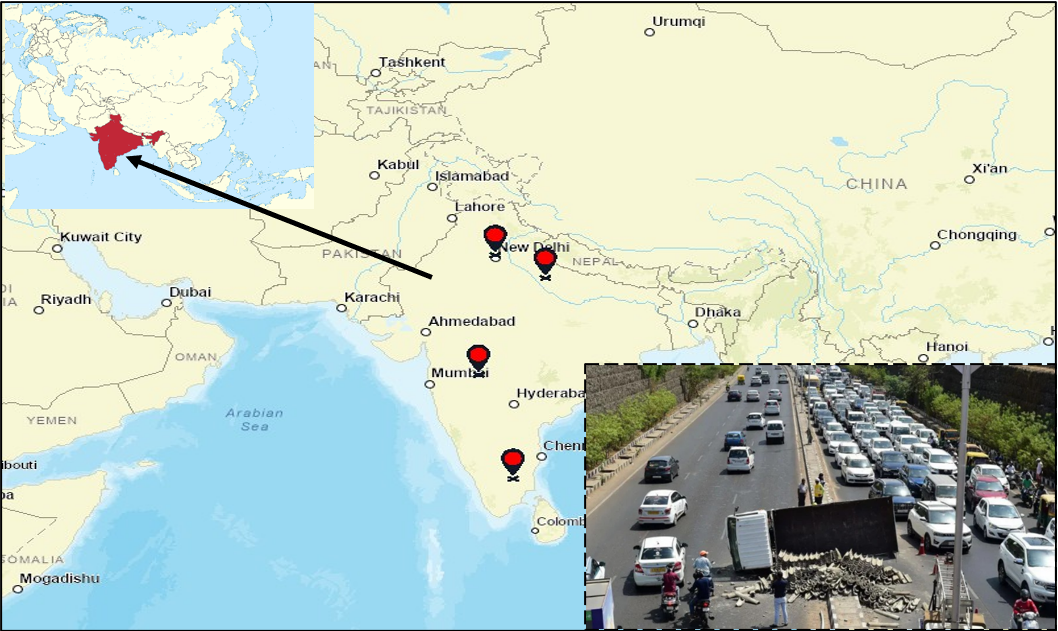| April 2025 | Location: India |
Incident Details
It has been reported that India recorded over 480,000 road accidents in 2023, resulting in more than 172,000 fatalities, averaging 474 deaths daily. This crisis highlights significant risks for business travellers navigating one of the world’s most dangerous road networks.

Figure 1: Map of Indias’s Road Accident Hotspots (Image Courtesy: BBC)
Comment. India’s road safety statistics of 2023 paints a grim picture, with over 480,000 accidents claiming more than 172,000 lives. This translates to an average of 474 deaths per day, a staggering toll that includes circa 10,000 children and 35,000 pedestrians. Among the specific causes, not wearing helmets contributed to 54,000 fatalities, while crashes involving unlicensed drivers accounted for 34,000 incidents. The economic cost is equally alarming, shaving approximately 3% off India’s GDP annually, according to Road Transport and Highways Minister Nitin Gadkari. This crisis is fuelled by factors such as speeding, which was responsible for 70% of road deaths in 2022, poor infrastructure, and lax enforcement of traffic laws. The Ministry of Road Transport & Highways has identified 13,795 accident-prone “black spots,” yet only 5,036 had been addressed by 2023, underscoring the slow pace of improvement.
Zooming out to a global perspective, India’s road death rate stands at 22.6 per 100,000 population, a figure derived from World Health Organisation (WHO) estimates. This is notably higher than nations like Sweden, which reports a rate of just 2.2 per 100,000, or the United States at 12.4 per 100,000. In contrast, other regions that face similar challenges are: Africa averages 26.6 per 100,000, with countries like Nigeria and South Africa reporting elevated rates. Thailand, another high-risk area, records 32.7 deaths per 100,000, while Europe as a whole maintains a lower average of 9.3 per 100,000. Countries like the Netherlands and Switzerland exemplify success, by keeping rates below 5 per 100,000 through stringent safety policies and infrastructure investment. Globally, road traffic injuries remain a leading cause of death, particularly in low and middle-income countries, claiming 1.19 million lives annually, per WHO’s 2023 data.
India’s government has responded with the “5Es” strategy – engineering, education, enforcement, emergency care, and environment – aiming to curb the crisis. However, persistent high fatality rates and public scepticism suggest these efforts have yet to yield significant results. For businesses, this underscores the critical need for robust travel safety protocols, especially in high-risk regions.
Assessment. The staggering 172,000 road fatalities in India during 2023 signal a pressing need for businesses to prioritise travel safety, particularly for employees operating in or traveling to high-risk regions. This crisis extends beyond statistics, posing real threats to operational continuity and employee well-being. Companies bear a legal and ethical duty of care to safeguard their workforce while travelling, necessitating a multi-faceted approach to mitigate risks effectively.
Effective travel risk management starts with a thorough pre-travel risk assessment. These should pinpoint specific hazards, using real-time data from travel management platforms. Such tools can map out safer routes, avoiding accident-prone areas, and provide updates on road conditions or weather-related risks. Beyond planning, businesses should invest in employee training tailored to local conditions.
Transportation choices also play a pivotal role. Companies should opt for secure options, such as pre-arranged vehicles with vetted, experienced drivers or reputable ride-hailing services, over reliance on public transport or self-driven rentals in unfamiliar settings. Complementing this, comprehensive medical insurance is essential. Policies must cover accident-related injuries, hospital stays, and emergency medical evacuation, given the variable quality of healthcare in rural or less-developed areas. A 24/7 emergency support line, linked to a global assistance provider, ensures swift response times, offering peace of mind to both employees and employers.
A robust crisis management framework is equally essential. This involves detailed contingency plans outlining steps for accident response, from immediate medical coordination to communication with employees’ families. Regular drills and clear protocols – such as designated emergency contacts, enhance preparedness. For multinational firms, aligning these plans with international safety standards, such as ISO 31030 (Travel Risk Management).
By integrating these measures – pre-travel assessments, training, secure transport, insurance, mobile phone monitoring and alert applications and crisis planning – businesses can substantially lower the risks tied to road travel in high-fatality zones. This not only protects employees but also shields companies from legal liabilities, reputational damage, and financial losses, ensuring resilience
Speak to our experts today to discuss your travel risk management plans Contact us at – Neptune P2P Group.
